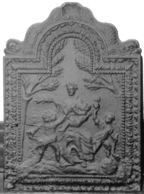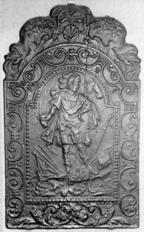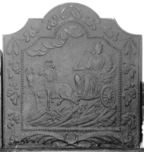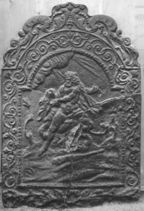-
138
Description: 'Dutch' style; arched rectangular shaped central panel with bead edging, figure of Charity holding a baby in her left arm and an olive branch in her right, two other children stand on each side of her, one holding a burning heart, trees in the background; arched rectangular shaped border with fillet edging and a repeated leaf pattern; on top a clam shell between two symmetrical serpents.
Notes: Typical type of fireback produced in Germany by Dutch pattern makers; the central panel was made separately for insertion into different borders; this border is a relatively simple type; the portrayal of Charity is derived from the 'Iconologia' of Cesare Ripa. Formerly part of the Ade Collection (from Grove Hill, Hellingly, Sussex).
Copies of this fireback are known.
- Decoration tags:
- 'Dutch' (shape)
- fillet (edging)
- carved pattern panels
- allegorical
- humans
- plants
Manufactured: in the mid- to late-17th century possibly in the Siegerland area of Germany.
Current location: Hastings Museum and Art Gallery, John's Place, Bohemia Road, Hastings, East Sussex, England.
Museum number: HASMG: 1952.51.40 (part of the Hastings Museum museum group)
Citation: Lloyd, N., 1925, 'Domestic Ironwork I', Architectural Review, 58, pp. 58-67.
- Attached to series:
- 'Dutch' Miscellaneous Firebacks
- Charity firebacks
-
123
Description: Rectangular; top panel with bearded face between symmetrical horizontal scrolls, and faces at either end; scrolls are repeated below, on either side of the date, all above a horizontal double fillet; below, a pair of arches with guilloche decoration between fillets, and toothed on the underside, are supported on each side by Tuscan columns, also with guilloche decoration; this is repeated in symmetrical rectangular panels on either side; at the centre base a bulbous nozzle protrudes.
Notes: This is a smith's forge fireback, the nozzle being the tuyere directing the air into the fire from bellows behind. Stylistically similar to the Lenard and other firebacks of the same period, the carved elements above the nozzle may have been cast from a pattern inspired by the back of a joined 'wainscot' chair, with the date inserted. The back may have been used for forging non-ferrous metals as there was a trade in pot-founding in bronze as well as iron at some ironworks in the Weald. Formerly part of the Ade Collection (from Grove Hill, Hellingly, Sussex).
Inscription: 1655
- Decoration tags:
- rectangular with round arch (shape)
- fillet (edging)
- whole carved pattern
- individual numbers
- architectural
- text
- humans
Manufactured: in 1655 in the Weald area of England.
Current location: Hastings Museum and Art Gallery, John's Place, Bohemia Road, Hastings, East Sussex, England.
Museum number: HASMG: 1952.51.62 (part of the Hastings Museum museum group)
Citation: Butterfield, W. R., 1916, 'Old Wealden Firebacks', The Connoisseur, 46, pp. 197-209.
- Attached to series:
- Chair pattern firebacks
- Furniture stamp firebacks
-
130
Description: Arched rectangular shaped central panel with bead on fillet edging; helmeted figure of Mars holding a cutlass in his right hand, standing on a field of flags, spears and cannon; 'Palladian' shaped border with fillet edging enclosing a repeated scrollwork pattern with floral arrangement at base; on top, symmetrical arrangement of scallop shell between two sea serpents and plant fronds.
Notes: Although in the 'Dutch'; style, an absence of this type in continental collections suggests an British source. Formerly part of the Ade Collection (from Grove Hill, Hellingly, Sussex).
Copies of this fireback are known.
- Decoration tags:
- 'Dutch' (shape)
- fillet (edging)
- whole carved pattern
- mythological
- humans
Manufactured: in the late-17th to early-18th century in England.
Current location: Hastings Museum and Art Gallery, John's Place, Bohemia Road, Hastings, East Sussex, England.
Museum number: HASMG: 1952.51.32 (part of the Hastings Museum museum group)
- Attached to series:
- British 'Dutch' style firebacks
-
139
Description: Arched rectangular shaped central panel with bead-and-pellet edging; figure of Abraham, a scimitar in his raised right hand, which is being restrained by an angel emerging from a cloud; Isaac is kneeling to Abraham's left and a ram is caught in a bush to the left of the plate; the initials are in the top corners; arched rectangular shaped border with fillet edging, and swags of leaves suspended from flowers; on top, symmetrical foliate swirls.
Notes: The design is an adaptation of an engraving by Adriaen Collaert (1555-1623) of a painting by Maarten de Vos (1532-1603), Plate 5 of The Story of Abraham. In the 'Thesaurus sacrarum historiarum veteris testamenti', published in Antwerp by Gerard de Jode (1509-1591) in 1579, 1585 and, subsequently, by Visscher in 1589. One of a small group of firebacks, all of similar shape, some with biblical designs, others mythological, all dated around 1700 and bearing the letters GK. Formerly part of the Ade Collection (from Grove Hill, Hellingly, Sussex).
Copies of this fireback are known.
Inscription: G K / 1700
- Decoration tags:
- 'Dutch' (shape)
- fillet (edging)
- whole carved pattern
- individual letters
- biblical
- text
- humans
Manufactured: in 1700 in the Siegerland area of Germany.
Current location: Hastings Museum and Art Gallery, John's Place, Bohemia Road, Hastings, East Sussex, England.
Museum number: HASMG: 1952.51.37 (part of the Hastings Museum museum group)
Citation: Lloyd, N., 1925, 'Domestic Ironwork I', Architectural Review, 58, pp. 58-67.
- Attached to series:
- 'Dutch' GK series
- Old Testament & Apocrypha firebacks
- Abraham & Isaac firebacks
-
143
Description: Central panel of arched rectangular shape with cavetto canted corners and bead edging; crowned female figure holding a sceptre in her right hand, seated in a chariot drawn by two caparisoned ponies, a cornucopia at their feet; below, sloping ground with plants, clouds with rain above; identically shaped border with fillet edging and symmetrical swags of flowers and drapery suspended from ribbons; at the base two symmetrical palm fronds tied with a ribbon.
Notes: The figure may represent Ceres, goddess of plenty. The fireback is one of a series designed and made in England, copying the prevailing 'Dutch' style. Its style echoes that of a fireback pattern preserved at Rottingdean Grange, Sussex. Formerly part of the Ade Collection (from Grove Hill, Hellingly, Sussex).
Copies of this fireback are known.
- Decoration tags:
- rectangular with canted top corners and round arch (shape)
- fillet (edging)
- whole carved pattern
- mythological
- animals
- humans
Manufactured: in the early-18th century possibly in the Weald area of England.
Current location: Hastings Museum and Art Gallery, John's Place, Bohemia Road, Hastings, East Sussex, England.
Museum number: HASMG: 1952.51.63 (part of the Hastings Museum museum group)
- Attached to series:
- Mayfield 'Dutch' series
- British 'Dutch' style firebacks
-
155
Description: Arched rectangular shaped central panel with paternost bead edging; Hercules/Herakles slaying the Nemean lion on a ground with small trees, his club lying at his feet; above, clouds and sun rays; arched rectangular shaped border with fillet edging, symmetrical arrangement of swirled tendrils, floral wreath at base; on top, symmetrical arrangement of foliage.
Notes: The image is taken from an engraving by Gerard de Jode, from his series 'The Labours of Hercules', after Marcus Geeraerts, 1519 - 1591. One of many English firebacks which copied 'Dutch' styles. Formerly part of the Ade Collection (from Grove Hill, Hellingly, Sussex).
Copies of this fireback are known.
- Decoration tags:
- 'Dutch' (shape)
- fillet (edging)
- whole carved pattern
- pictorial
- mythological
- humans
Manufactured: in the early-18th century in England.
Current location: Hastings Museum and Art Gallery, John's Place, Bohemia Road, Hastings, East Sussex, England.
Museum number: HASMG: 1952.51.27 (part of the Hastings Museum museum group)
- Attached to series:
- British 'Dutch' style firebacks
-
160
Description: Arched rectangular shaped panel with fillet edging; two Salomonic columns supporting a beaded arch; standing figure of Atlas supporting a globe, on ground with plants, and two swags of fruit and leaves suspended from the centre of the arch to the capitals of the columns; above the beaded arch, symmetrical swirls of fruit and foliage; on top, a scallop shell between two sea serpents.
Notes: Probably an English design copying the north German 'Dutch' style.
Copies of this fireback are known.
- Decoration tags:
- 'Dutch' (shape)
- fillet (edging)
- whole carved pattern
- mythological
- architectural
- humans
- plants
- objects
Manufactured: in the late-17th to early-18th century in England.
Current location: Hastings Museum and Art Gallery, John's Place, Bohemia Road, Hastings, East Sussex, England.
Museum number: HASMG: 1917.196.6 (part of the Hastings Museum museum group)
Citation: Butterfield, W. R., 1916, 'Old Wealden Firebacks', The Connoisseur, 46, pp. 197-209.
Citation: Lloyd, N., 1925, 'Domestic Ironwork I', Architectural Review, 58, pp. 58-67.
Citation: Baines, J. M., 1958, Wealden Firebacks (Hastings Museum).
- Attached to series:
- British 'Dutch' style firebacks
-
163
Description: Arched rectangular shape with fillet edging; tall, arched central panel with bead edging (top and sides); flying bird in arch, with two small trees below, and two figures, one with a staff in his right hand, and a dog, at the bottom; two side panels with similar cascades of flowers; narrow base panel with fillet edging and symmetrical floral arrangement; on top, a scallop shell between two symmetrical lines of trailing flowers.
Notes: The figures may be Venus and Adonis, the bird aboive being a dove; probably an English design based on the 'Dutch' style. Formerly part of the Ade Collection (from Grove Hill, Hellingly, Sussex).
Manufactured: in the late-17th to early-18th century in England.
Current location: Hastings Museum and Art Gallery, John's Place, Bohemia Road, Hastings, East Sussex, England.
Museum number: HASMG: 1952.51.31 (part of the Hastings Museum museum group)
- Attached to series:
- British 'Dutch' style firebacks
-
168
Description: Quasi-arched shape; straight fillet edging to sides and bottom, symmetrical, stepped cavetto, ovolo, cavetto and double arched on top; central pictorial scene of a female and male seated on a couch, both in 18th century dress, with swirled floral border; swirled floral base panel separated by a fillet; two sea serpents on top.
Notes: The dress of the figures portrayed suggests a late-18th century date
- Decoration tags:
- rectangular with ornate arch (shape)
- fillet (edging)
- whole carved pattern
- pictorial
- humans
- objects
Manufactured: in the late-18th century in England.
Current location: Hastings Museum and Art Gallery, John's Place, Bohemia Road, Hastings, East Sussex, England.
Museum number: HASMG: 1910.36 (part of the Hastings Museum museum group)
- Attached to series:
- Miscellaneous pattern firebacks
-
171
Description: Quasi-rectangular with raised symmetrical scrolls between semi-circular re-entrants on top edge; ovolo-moulded edge on bottom and sides, with fillet edging on top; grotesque face with swirled hair locks, above an inverted floral spike, between two moustachioed male figures in tunics, holding pikes, standing on a cavetto-moulded compartment, date beneath.
Notes: Alleged to represent the 'Brede Ogre', Sir Goddard Oxenbridge (1478-1531) who, legend states, was sawn in half by local children. Stylistically similar to other firebacks with connections with Brede furnace.
Copies of this fireback are known.
Inscription: 16 52
- Decoration tags:
- rectangular with ornate arch (shape)
- fillet (edging)
- whole carved pattern
- individual numbers
- pictorial
- text
- humans
Manufactured: in 1652 probably at Brede Furnace in the Weald area of England.
Current location: Hastings Museum and Art Gallery, John's Place, Bohemia Road, Hastings, East Sussex, England.
Museum number: HASMG: 1924.42 (part of the Hastings Museum museum group)
Citation: Baines, J. M., 1958, Wealden Firebacks (Hastings Museum).
Citation: Butterfield, W. R., 10 Mar 1934, 'The Brede Ogre', Hastings and St Leonards Observer.
- Attached to series:
- Hooked '1' series
- Brede group









